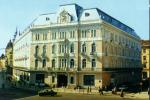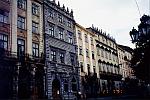MONDAY JULY 21 (con't)
The drive to L'viv takes two hours. Arrangements have been made for us to stay with a family of Ivanka's. This place is on the outskirts of town in an enormous complex of apartment buildings. I feel it will be more convenient to stay at a hotel in the centre of town and my hostess is in agreement. She accompanies us to town. The narrow cobblestone streets of L'viv were not built with cars in mind. I, relegated to sitting on Bill's lap am grateful when we arrive at the Hotel George.
Constructed at the turn of the century, the George is a lovely old hotel. The room is sparsely furnished but is reminiscent of bygone years with a wonderful high ceiling estimated at twelve to fourteen feet. A portion of floor near the bathroom gives way under foot pressure, and I wonder at which time I may end up in the suite below. Bill and I are sad as we walk down the neat old staircase and out onto the street to say goodbye to our gracious hosts.
L'viv, the largest city in western Ukraine was founded in the thirteenth century by Prince Danylo Halitskiy. It was named after his son Lev which means "lion". Over the centuries L'viv has endured invasions by a multitude of countries including Poland, Sweden, and the Austro-Hungarian empire. It was occupied by Germany, but it was fortunately spared the bombing. Many people are multilingual owing to the many changes in boundaries and this area is also rich in folklore.
A map of the major sights is posted on the wall at the tourist office in the hotel. With assistance from an employee, we sort of map a walking route. A few steps from the George is Ploshcha Mitskevycha. A column topped with a statue of the poet Adam Mitskevycha is in the centre of this busy intersection. We easily find the 14th century Roman Catholic Cathedral. It appears to take up a block of property. Inside are impressive carvings, statues and frescoes. I have difficulty figuring out what is the Kampiany chapel, but figure we must have seen it amongst all the paintings and gilded paraphernalia. Across the courtyard that I am to understand was once a cemetery is the wonderful little Boyim Chapel. The chapel is closed but we spend considerable time looking at the superb stone facade. Perched on the roof is an unusual statue in a sitting position. A weird lightening bolt like halo is hovering over the head that is held in remorse by it's hand.
After a short walk beyond a small park, we are at Ploshcha Rynok or the medieval market square. In the centre of the square is the imposing City Hall with it's adjacent clock tower. At each corner are fountains adorned with statues of Greek Gods. Wanting to see the view from the top of the tower, we scoot through the entrance guarded by majestic stone lions. A myriad of office buildings is all we find, so we exit and encircling the perimeter of the square, we continue our quest to see all the tourist places. There are about forty building, of varying ages and degree of interest ranging from plain facades to the very decorative. Stone carved human faces incorporated into those of lions are a popular adornment in this part of the country. Many buildings were built by Polish nobility. Chorna Kamyanytsya (black building) is said to have obtained its black colour when the stone was rubbed with the juice of unripe nuts. Nearby is Kornyakt's palace, the fanciest building in the square. Built for a wealthy Greek merchant it was at one time occupied by King Jan Sobieski of Poland. We find the old pharmacia, but the chemist's museum eludes us. We wander in and out of shops and find many have kept the original concept of the buildings during restoration. We had occasion to travel through Ploshcha Rynok on a few occasions, but could never find the Pid Levom restaurant open, where the winged stone lion above the door is kinda cute.
Clouds are hanging low and it is cold, so we retreat to the hotel for warmer clothing. Our next explore takes us along Prospect Svobody. The broad tree lined boulevard is filled with clusters of men playing chess or just talking in groups. Many vendors are selling stuff, primarily books. I am sorry that I stop to look through some lithographs, as it is soon apparent that they are not to my taste, but the artist will not let me go until I have looked at each and every picture he has created. What does hold my attention is a lovely statue of Shevchenko and the most remarkable obelisk type structure on the same stone base. Wretched figures depicting starvation and fear (dates 32-36-41) are at the base and rising up is representative of the struggle of Ukrainians, culminating at what appears to be independence commemorated at the top. The corners and backside of this outstanding monument are filled with carved faces exhibiting strong emotion. It is extremely well done. The Ivan Franko Opera Theatre is closed, but we encircle it, impressed by it's exterior facade of bronze and stone statues. A "yama" (depression or pothole) in front once contained a statue of Lenin, but now flowers bloom in the large hole. At this late hour the National Museum, Ukrainian Drama Theatre and the Ethnography and Craft museum are closed, but still worth a walk by. The latter has what appears to be a copy of the Statue of Liberty looming on top. Again, the predominant theme decorating buildings is the lion. We pass near the Jesuit Church but leave it for another day. Well there goes my record of visiting every church in L'viv as we failed to return to this area.
There is still light so we wander down Prospect Shevchenko. The boulevard appears exceptionally wide as there are few trees. There are many stores along this route. Large food outlets are well stocked not only with provisions but each has an abundant supply of alcohol for sale. This appeared the norm in Ukraine. There is also a flurry of renovation of buildings in this part of town. We rest at the statue of Mykhailo Hrushevsky, the country's first president. A few steps further is the small St. Nicholas church, but we are getting tired so do not investigate. We wander along quaint back streets in the direction of the hotel. There are many colourful buildings but they are less ornate than those in the centre of town. Ivy growing from the buildings across the hydro wires to the other side provides an interesting canopy.
The hotel restaurant is closed so we go next door. Two employees at the door are reminiscent of the old trip as they are less than eager to seat us, but later they lighten up and are friendly when we leave. L'viv beer is very good and the meal fills a hole. I immerse my tired body into the enormous old tub, with the water up to my shoulders. I do not dawdle as planned for the face cloth has turned brown from the muddy water. We had purchased mineral water for brushing our teeth. Well, this is different as the toothpaste fizzes when I rinse my mouth. Sleep does not come easily as the music is loud from a theatre across the street.

All materials herein are copyrighted by the author. Permission must be granted by the author for any use of the material (text or images) contained in this diary. E-mail: theclarks@telus.net.


